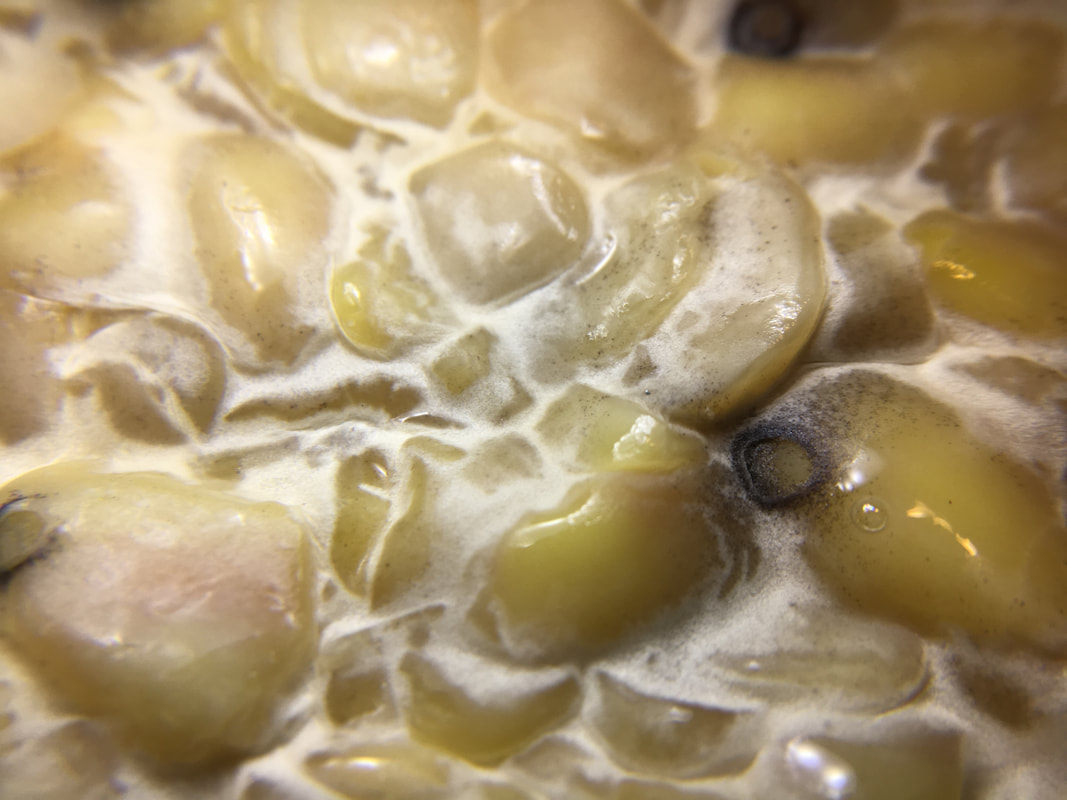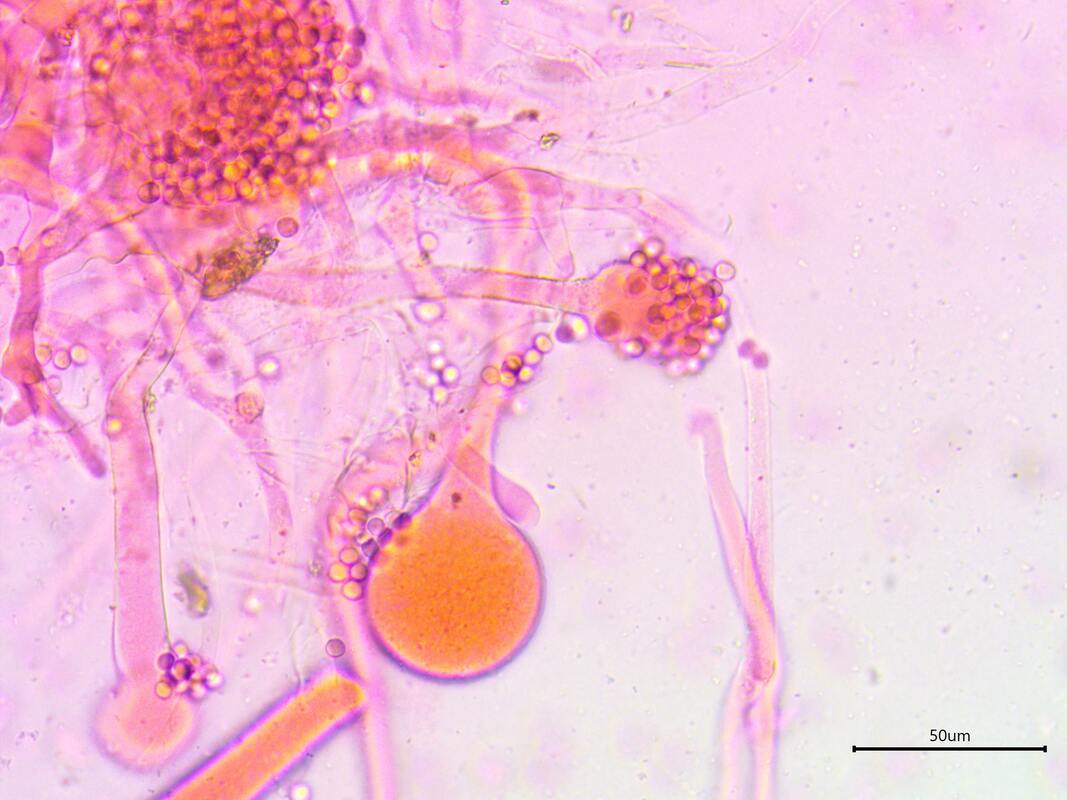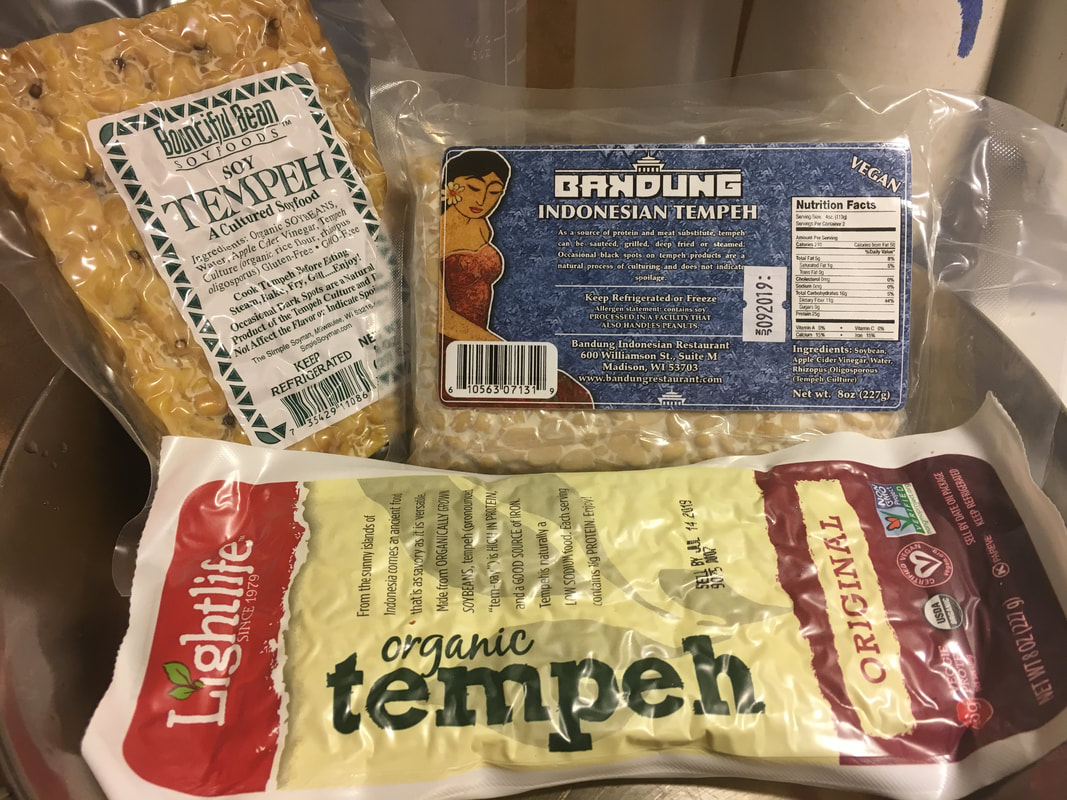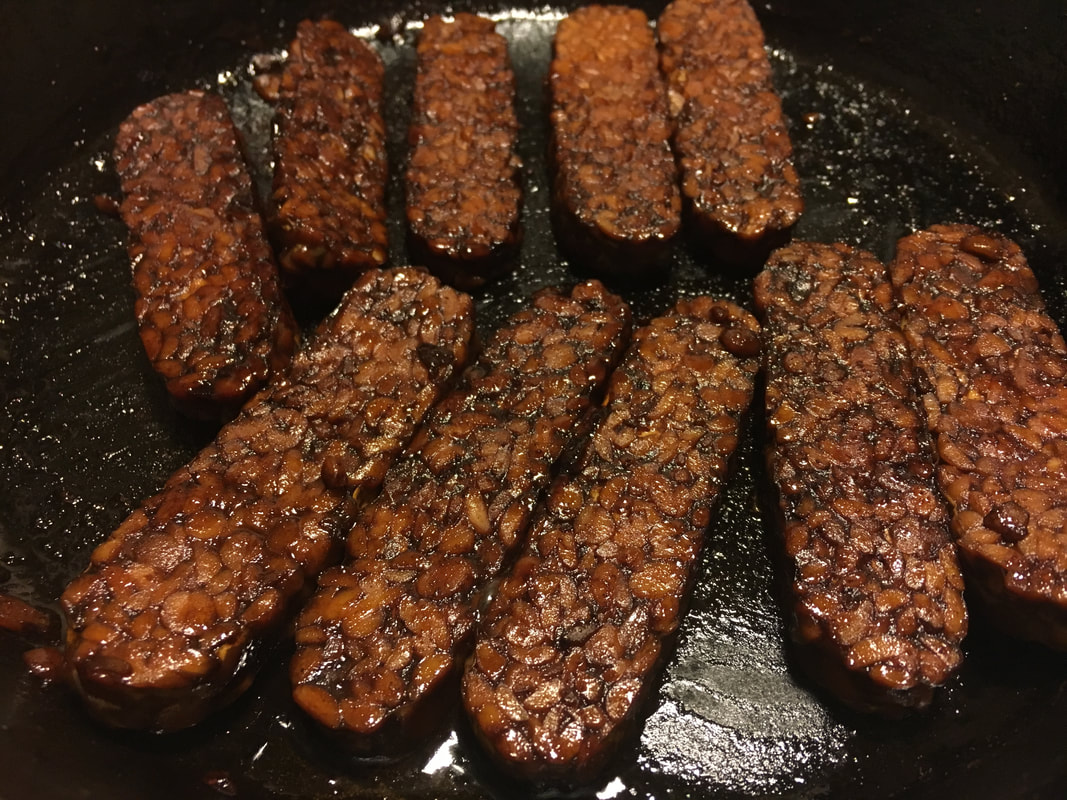|
Mycobank Taxonomy: Fungi, Mucoromyceta, Mucoromycota, Mucoromycotina, Mucoromycetes, Mucorales, Mucoraceae, Rhizopus Things have been slow in the field. Right when it seems like there should be morels, it snows. No worries, our refrigerators and pantries are full of fungi. While most of these are molds that we don't want, Rhizopus oligosporus growing on soybeans is one that we do. Better known as tempeh, this Indonesian fermented food is almost more fungus than bean. The white mass holding the beans together is the mycelium of the fungus, which is composed of string-like cells called hyphae. The black spots are areas where R. oligosporus has sporulated. Black, white, and grey are all normal colors on tempeh--more colorful filamentous molds are not. Raw tempeh is edible but like all fungi it is best cooked. Cooking aids in digestion by breaking down chitin in the cell walls--the same substance found in the exoskeletons of arthropods. Would you want to eat a raw shrimp shell? Cook your mushrooms! Rhizopus oligosporus is fascinating because it is actually a domesticated species. Through successive subculturing over thousands of years, Southeast Asian peoples artificially selected for a new fungus species. This is evident in features such as loss of mycotoxins that make it safe to eat and changes in spore morphology—what an amazing example of mycological and agricultural ingenuity. Most of the fungi that I showcase on this blog will be from the taxonomic phyla Ascomycota and Basidiomycota. Rhizopus oligosporus, on the other hand, belongs to the phylum Mucoromycota, which contains many of the fungi previously classified in the now-obsolete phylum Zygomycota and are colloquially referred to as zygomycetes. Zygomycetes produce asexual spores (sporangiospores) on structures called sporangiophores. If we zoom into the one of the black spots on this tempeh, we can see these sporangiospores as clumps of spores on a stalk. Growing up, I was not a fan of tempeh's bitter taste. I still find it to be slightly bitter, but I love the density of it as well as the sour, fungal, and nutty notes. I wanted to get a sense of the range of flavor profiles of tempeh so in this post I am doing a side-by-side comparison of the three brands available at my local grocery store: Bountiful Bean from Milwaukee, Bandung from Madison, and Lightlife from Massachusetts. Bountiful BeanThe raw taste of Bountiful Bean stood out the most to me. It was nutty and smooth, creamy even, and reminded me of bread. Both in look and flavor it seemed to be the most aged. The soybeans had reddish-brown hue and there was a regular pattern of sporulation; my best guess is that this grid is a result of the inoculation process, but I'm very curious what the explanation is. Overall it was very dense, which is evident in the cross section showing tightly packed soybeans and little room for the mycelium to grow. BandungThe mycelium is explosive on Bandung tempeh. There are no black sporulation areas. In cross section the mycelium has plenty of open space to form fluffy white growths, creating a pliant and light tempeh block. The mouthfeel is still pretty creamy, although the raw taste is fairly neutral compared to Bountiful Bean. I'd say that this tempeh was given less time to ferment. LightlifeLightlife tempeh was intermediate in both look, taste, and texture to Bountiful Bean and Bandung. It had a few black sporulation areas and was slightly less dense-feeling than Bandung tempeh. The most notable quality was a sourness that was not present in either of the two other tempeh brands. Apparently Rhizopus oligosporus is not alone in transforming soybeans into tempeh. Lactic-acid bacteria are part of the fermentation process. It seems to me like Lightlife's procedure, whether on purpose or by accident, results in more lactic acid bacteria lending the raw taste of this tempeh a notable sour quality. Tempeh is tempeh after cookingYou cook them up and they all taste the same. Tempeh is tempeh, delicious and nutritious. I marinated each block of tempeh for 45 minutes in the following mixture:
I cooked the tempeh on a skillet until the marinade evaporated away and the tempeh began to brown (beyond the color of the marinade). Perhaps a lighter flavor treatment would have allowed the distinct tastes of the tempeh to come through, but I equally enjoyed all three brands after cooking like this. What's your favorite way to eat tempeh? SpecimenACD0131; 17 April 2019; Dane Co., WI, USA; store-bought cultivated fungus, MICH 340468. ReferencesJennessen, J., Schnürer, J., Olsson, J., Samson, R. A., & Dijksterhuis, J. (2008). Morphological characteristics of sporangiospores of the tempe fungus Rhizopus oligosporus differentiate it from other taxa of the R. microsporus group. Mycological Research, 112(5), 547–563. https://doi.org/10.1016/j.mycres.2007.11.006 Spatafora, J. W., Chang, Y., Benny, G. L., Lazarus, K., Smith, M. E., Berbee, M. L., … Stajich, J. E. (2016). A phylum-level phylogenetic classification of zygomycete fungi based on genome-scale data. Mycologia, 108(5), 1028–1046. https://doi.org/10.3852/16-042
0 Comments
Your comment will be posted after it is approved.
Leave a Reply. |
PermalinksProject Introduction Top EdiblesHericium coralloides
Laetiporus sulphureus Morchella americana Polyporus umbellatus Suillus ampliporus Archives
April 2023
Categories |
|
|
Terms of Use, Liability Waiver, and Licensing
The material on aldendirks.com is presented for general informational and educational purposes only, and under no circumstances is to be considered a substitute for identification of an actual biological specimen by a person qualified to make that judgment. Some fungi are poisonous; please be cautious. All images on this website are licensed under Attribution-NonCommercial-NoDerivatives 4.0 International (CC BY-NC-ND 4.0). |




 RSS Feed
RSS Feed




